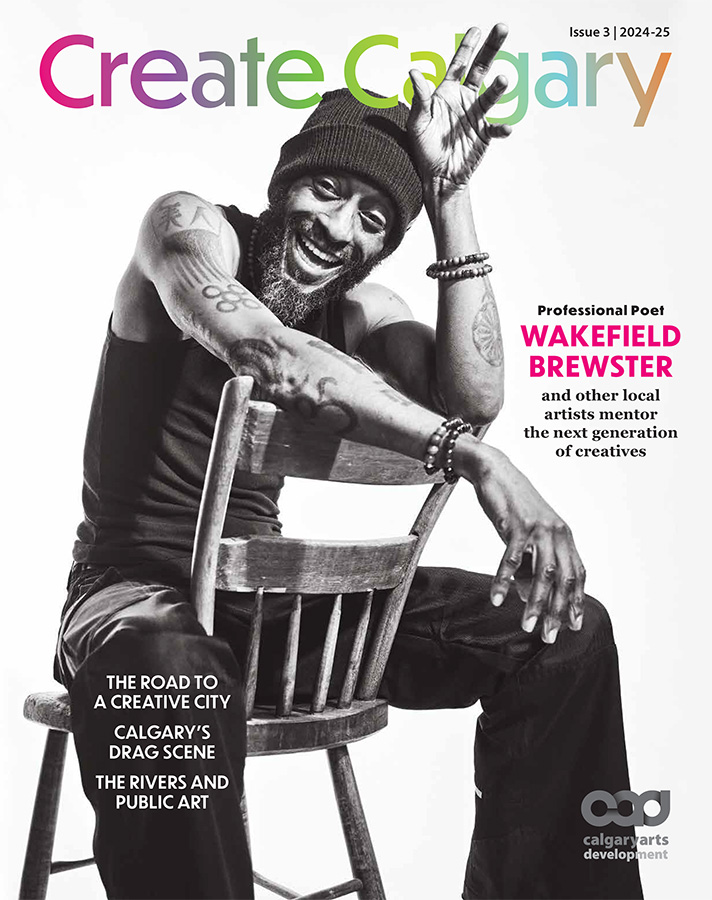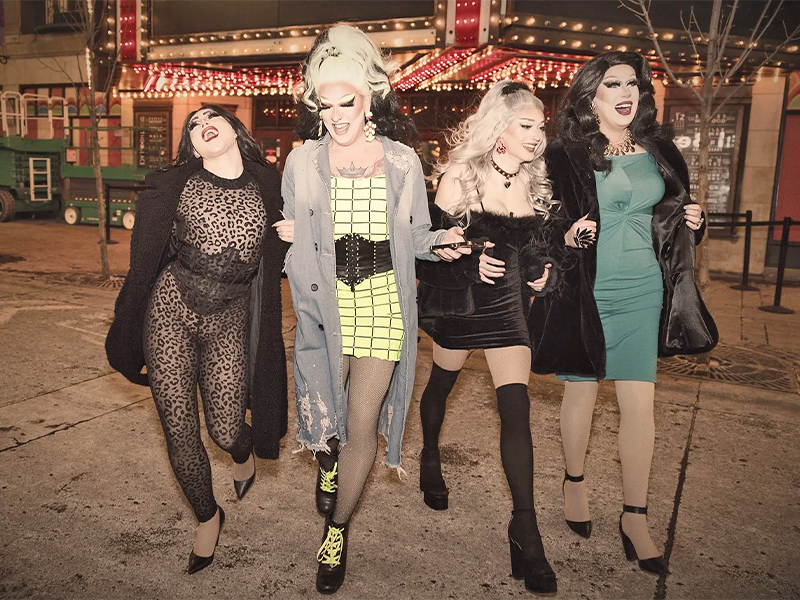Slay All Day
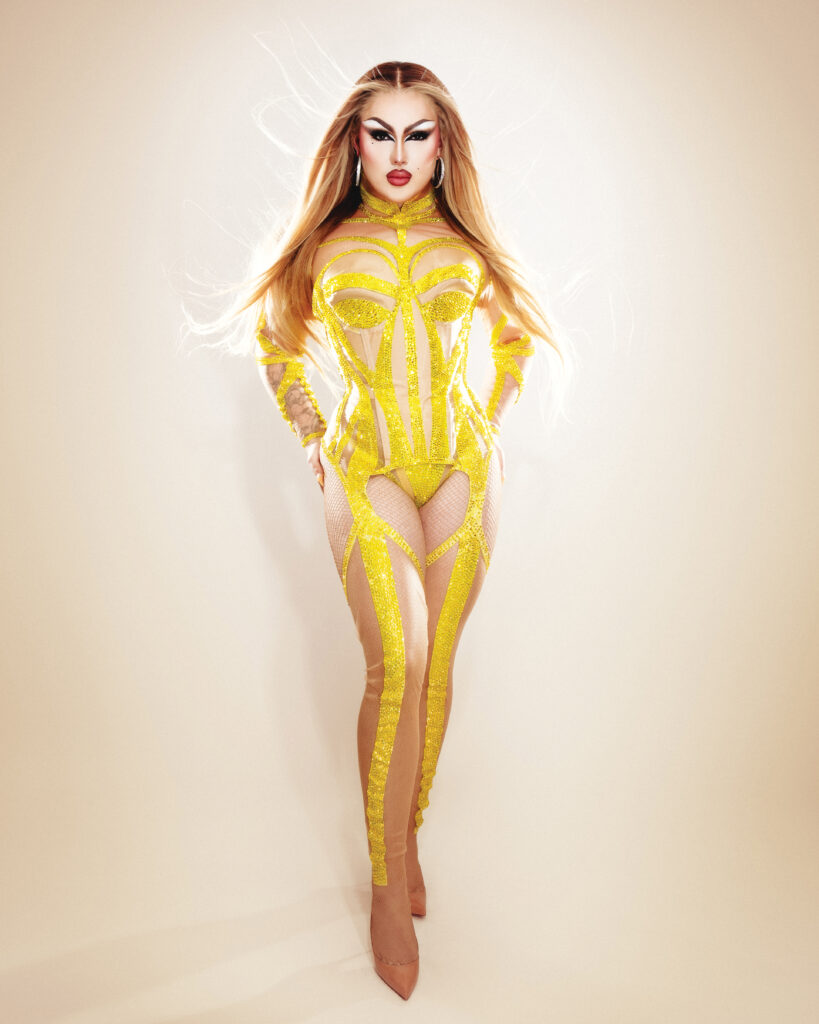
Nearah Nuff
Last year, Nearah Nuff, a 23-year old drag performer from Calgary, gained international fanfare after appearing (and, spoiler alert, placing in the top four) on Canada’s Drag Race, a spinoff of the global television phenomenon that is RuPaul’s Drag Race. With her cherubic good looks, confident demeanour and gravity-defying dance moves, the artist enchanted audiences and earned fans from around the world.
While Nearah’s Drag Race run was fun and seemingly effortless, earning a spot on the national stage was the result of years of developing her own personal talent with the support and mentorship of Calgary’s own robust local drag scene. Nearah may have helped put Calgary drag on the televised map, but it was Calgary that got her on that road in the first place.
“I made it the farthest [that] anyone in Alberta has gone on that show,” she says (for the purpose of this story, all performers will be referred to by their drag names and pronouns). “I feel like the Alberta talent we have is very underrated. There are so many talented performers who deserve a chance to be recognized in this way.”
To drag fans solely familiar with performers they see on shows like Drag Race, the news that Calgary is teeming with local drag performers, carefully pulling on wigs and adhering mile-long false eyelashes to perform day in and day out may come as a surprise. But it doesn’t take much digging to find live drag shows happening throughout the city, with everything from drag bingo and brunches to full-on musicals or classic cabaret-style shows starring drag queens, drag kings and artists of all gender identities taking place at nearly every kind of restaurant, theatre and bar. The popularity of reality TV contestants may have made drag more visible to non-2SLGBTQIA+ audiences, but drag in Calgary long predates the advent of RuPaul’s Drag Race in 2009.
A LONG AND PROUD DRAG PRESENCE IN CALGARY
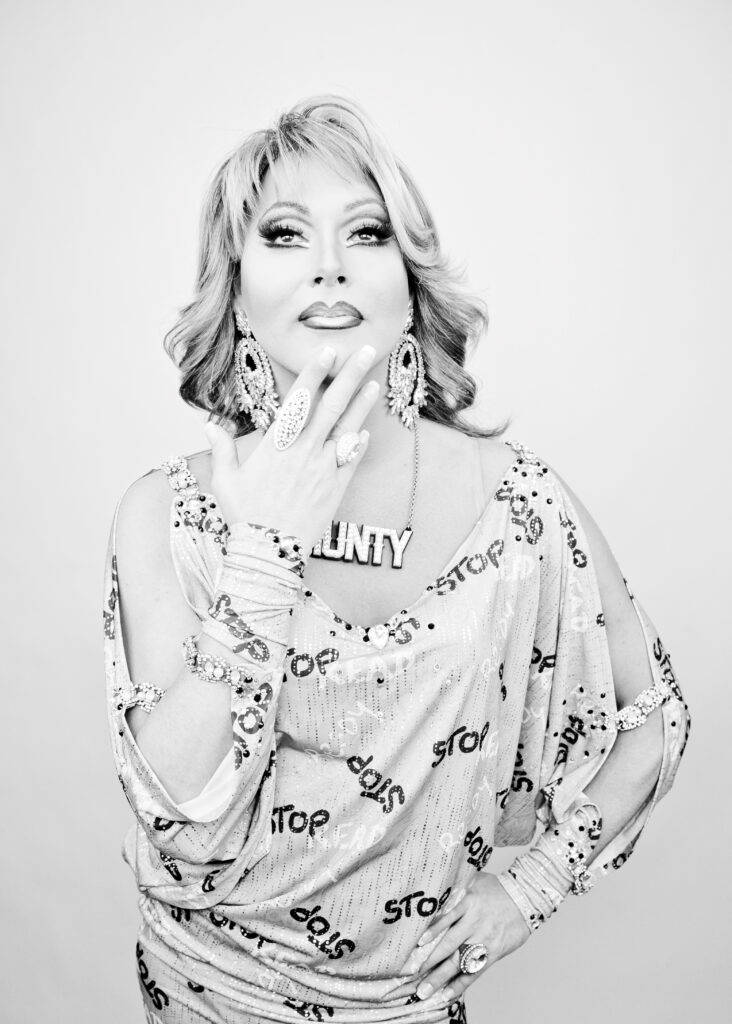
Carly York-Jones
“There were tons of queens back when I started, and there still are tons of queens today,” says Carly York-Jones, the star of Carly’s Angels, a drag show that has been running in the Inglewood vegan pizza and pasta restaurant and bar The Attic (and a string of other bars and restaurants occupying the space before it) since 2000. “We’re just in different locations. Drag doesn’t necessarily have to be part of an underground scene with an adult-only aspect to it anymore.”
While York-Jones is far from being the most veteran drag performer in Calgary (Mercedez, one of her “angels,” has proudly been performing for over 40 years), she is a couple of generations older than Nearah. York-Jones started performing in the early ’90s in Winnipeg as a point of entry into the local gay bar scene — as a young person coming to terms with her own sexuality, drag provided a sense of community and connection. While drag has expanded to include different styles of expression in the years since she started, York-Jones’s act still falls into a traditional definition of drag — that is, a male-identifying person dressing in an exaggerated style of clothing, hair and makeup typically coded as female while performing a combination of dancing, lip syncing and comedy, all with a hefty dose of charisma and charm.
York-Jones may not be reinventing the wheel when it comes to her brand of drag, but she is a trailblazer via her vision of creating a show that takes drag beyond traditionally 2SLGBTQIA+ spaces to perform in a restaurant setting, inviting in audiences of all identities and backgrounds to come along with her. She loves her classic style but is also moved by the ways in which the definition of drag performance has evolved over the decades.
“Our show is sort of the vanilla aspect of the rainbow at this point,” York-Jones says. “That rainbow has added quite a few colours to it. We see women, heterosexual, non-binary and trans performers. There are just so many different types of acts under that drag heading, which is wonderful to see.”
AN EXPANDING RAINBOW OF PERFORMERS
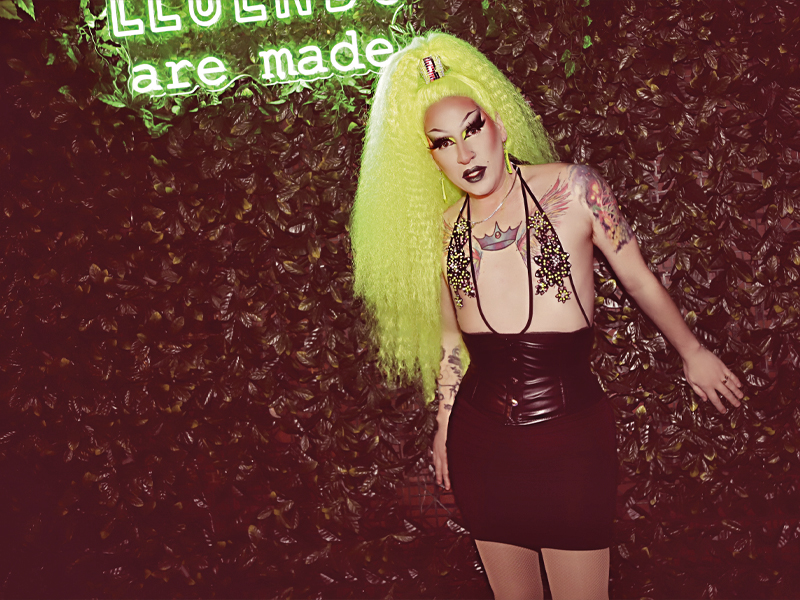
Farrah Nuff
The drag rainbow includes Farrah Nuff, a non-binary-identifying performer with a background as a competitive dancer. Farrah’s look often trends towards the gender non-conforming: they’re often clad in a lime-green wig and makeup, with tattoos exposed and in a bodysuit with minimal or no padding at the chest. A Farrah show is marked by high energy, intricate dancing and expertly executed lip-syncs, all performed with an abundant sense of joy. The performer, who started doing drag nearly 20 years ago, was looking for a way to continue practising the skill they’d developed as a competitive dancer. While working in a 2SLGBTQIA+ club, they were coaxed from behind the bar to try their hand at drag and became part of the regular roster of performers less than a month later.
Farrah has passed their wisdom and spirit down to their own drag daughter, the aforementioned Nearah Nuff (“drag mother” and “drag daughter” can be a mentorship relationship, usually referring to the person who guides a new drag performer and provides caregiving), who, after a childhood of competitive dancing and watching Drag Race with her stepmother, as well as training as a makeup artist, approached Farrah about pursuing drag. With all of that experience, the skill quotient is high, but both Nuffs and their extended “Nuff Family” also use drag to build community and as a form of personal expression.
“Farrah is a part of who I am as an individual,” Farrah says. “Drag has been a wild journey of self-discovery and performance opportunities. It is also about family and having people to support you that you chose to be related to as opposed to blood relations.”
Farrah has also been proactive as a businessperson, on a mission to open the door even wider for audiences of all identities. In the spring of 2020, near the beginning of the pandemic, Farrah and their drag sister Nada Nuff launched HireHeelsYYC, a booking agency and production company that gained ample news coverage with its curbside Mother’s Day performances. It gave performers the chance to continue the momentum of local drag’s popularity, even as traditional performance venues shut down.
DRAG ISN’T ONLY AT DRAG SHOWS
Like Farrah, Mavis Vontrese uses drag for self expression and performance. “I was always doing drag, but only in private,” she says. “I was always dressing up and performing.” Vontrese, who grew up on the Kainai Nation in southern Alberta, began publicly performing drag during her theatre degree at University of Lethbridge. Moving to Calgary in 2017, she performed in many drag, cabaret and theatre shows. She’s also incorporating drag into her professional theatre work.
Since 2019, she has played the Ghost of Christmas Present in Theatre Calgary’s A Christmas Carol. “I love the idea of storytelling and how drag can be a part of theatre,” she says. “In collaboration with the costume design team, director, playwright and my acting style, it became a drag character. Traditionally, that ghost is a hungry bearded man, but that abundance can also refer to an abundance of queer joy. I love when we can be open to thinking of things in new ways. The role was about being larger than life and I pushed in the direction of drag, but no one was opposed or said it was a bad idea. People seem receptive to it.” Vontrese also points to how mainstream shows are beginning to house and even dedicate drag characters within them, such as Kinky Boots or locally, Lunchbox Theatre’s With Bells On holiday show.
THE LOCAL DRAG STRUGGLE IS REAL
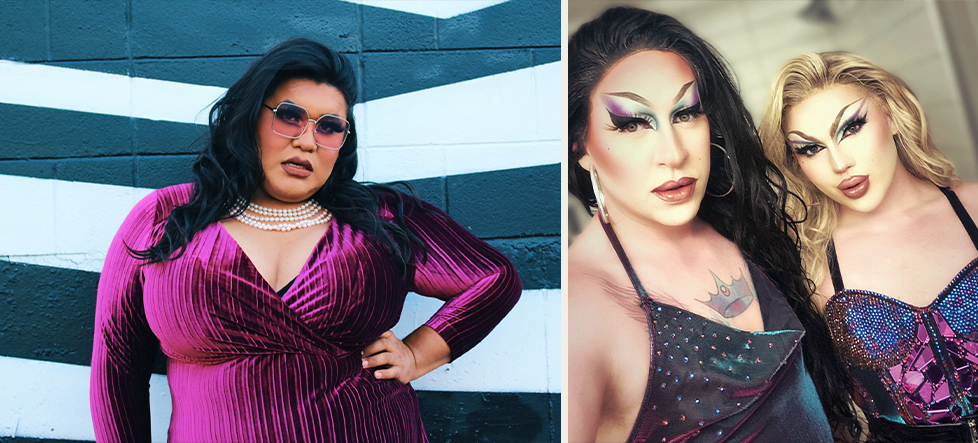
Left: Mavis Vontrese. Right: Farrah (left) and Nearah Nuff.
Even with that community support, local drag performers still often struggle to attract the kind of attention the touring superstars of Drag Race enjoy. Even though drag shows are commonplace in Calgary, local artists have to work hard to build fan bases, command reasonable performance fees and earn the cash tips traditionally handed to the stage during a drag show. Making a full-time living as a drag performer is rare — Farrah points out that the pay isn’t high and there’s not always enough work — and maintaining the gear required is a costly endeavour.
York-Jones says she’s satisfied to earn enough to keep herself in professional-level wigs and glamorous gowns. The reality is, most performers in Calgary don’t expect to be able to quit their day jobs. As successful as they are, York-Jones and Farrah have professional careers outside of drag, and Vontrese also works as an actor, director, playwright and producer. But even if most artists aren’t getting rich, maintaining a local drag community requires audience support.
“If people want more local queens from Calgary representing on bigger platforms like Drag Race, they need to show up and show out,” Nearah says. “It gives us more opportunities to work, make more money and invest into our crafts. Every time a person tips a drag queen, they’re investing into their local queer community.”
Supporting and celebrating local drag doesn’t just grow specific artists, it also provides representation to Calgarians who may be exploring their own gender expression. Carly’s Angels’ home base, The Attic, saw a series of protests outside its doors throughout late 2022 and early 2023 over a series of all-ages drag brunches it was hosting. Similar protests have taken place in front of libraries hosting Reading with Royalty drag storytime programs, prompting The City of Calgary to enact a bylaw prohibiting protests within 100 metres of a City-operated recreation facility or library.
INCLUSIVITY MATTERS
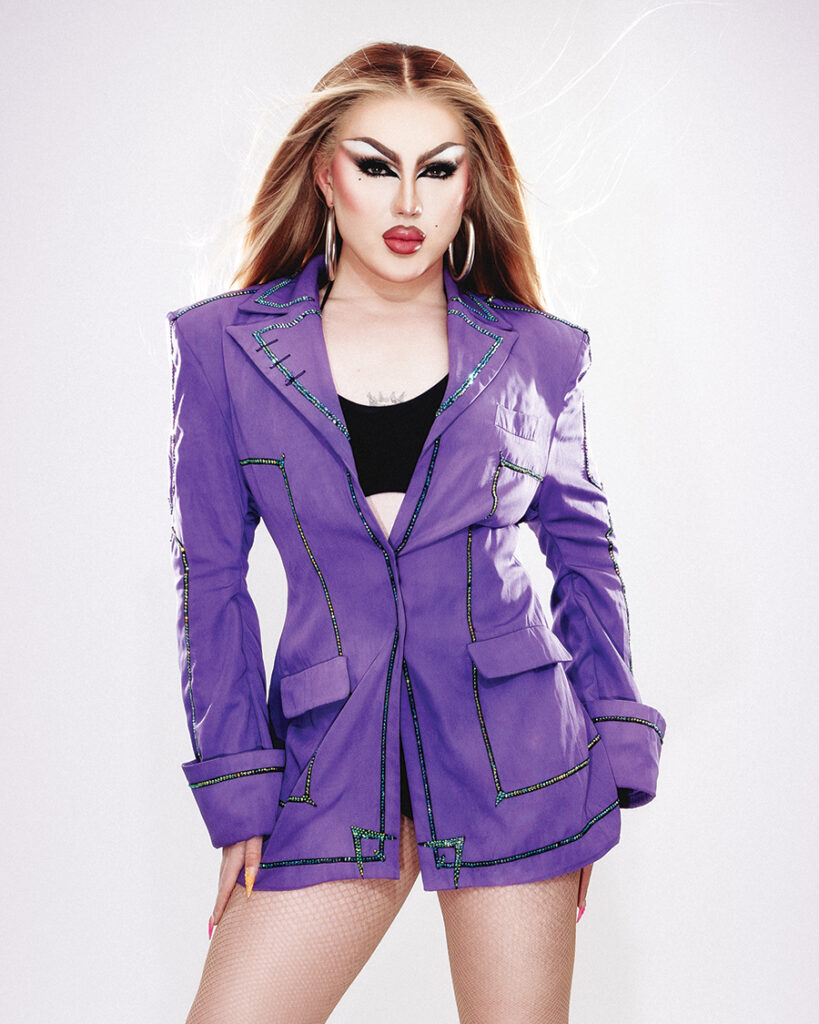
Nearah Nuff
“It’s easy to villainize drag as an art form because it’s always existed on the margins of creative expression. In today’s political climate, it can be scary to do shows in public,” admits Vontrese. “But in order to break the stigma, we need to be open and allow space for all forms of drag to exist. For me, drag is a way for me to free the feminine as a Two-Spirit person, to bring people together and share queer joy. There truly is room for everyone, and it’s lovely seeing people from underrepresented communities take up space in the drag scene — from non-binary performers to performers with disabilities and from neurodivergent communities. All of that feels good. And I would love for more Indigenous performers to explore the art form and step into their power. Promoters and producers need to be intentional about who is being invited to participate in shows. Drag spaces need to be safe and accessible to make this possible.”
With a growing cohort of young, gender non-conforming Calgarians looking for role models, Farrah, who has personally been the target of a harassment campaign by an anti- 2SLGBTQIA+ group, believes some of the public pushback against drag highlights how important the art form is. “If you don’t have haters, you’re not pushing boundaries,” they say. “If you’re not pushing boundaries, you’re not breaking ground or breaking moulds.”
York-Jones adds that while exposure to drag was important for her when she was a young person discovering her identity and community over 30 years ago, drag’s growing openness and inclusiveness are just as important in the here and now. “I love looking feminine,” she says. “I like the pretty — I like the jewels and the rhinestones and the hair. But I know queens out there that go 100 per cent in the opposite direction, and they have an audience, too.”
Ultimately, that boundary pushing, along with drag’s ability to delight, entertain and inspire, is why supporting a robust local drag scene and a place where audiences can see performers beyond their screens is crucial. “What’s been so nice about seeing drag come to the forefront is that it’s been easier to combine my drag persona with my theatre persona — combine my identities in a way,” says Vontrese. “I want to be taken seriously in theatre, but now I can feel comfortable adding some of my drag attributes in those spaces and be my whole self.”
This article was originally published in the 2024 edition of Create Calgary, an annual magazine launched by Calgary Arts Development to celebrate the work of artists who call Mohkinsstsis/Calgary home.
You can pick up a free copy at public libraries, community recreation centres and other places where you find your favourite magazines. You can also read the digital version online here.
